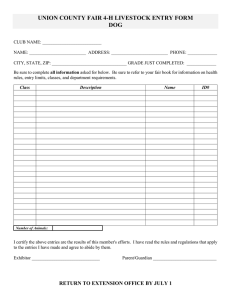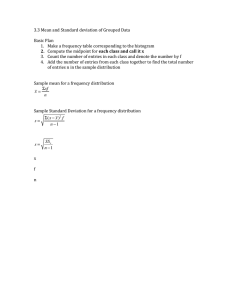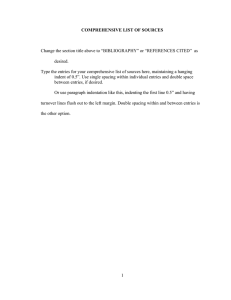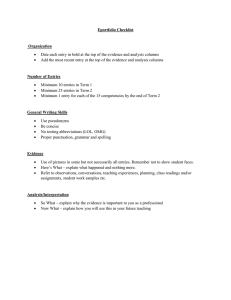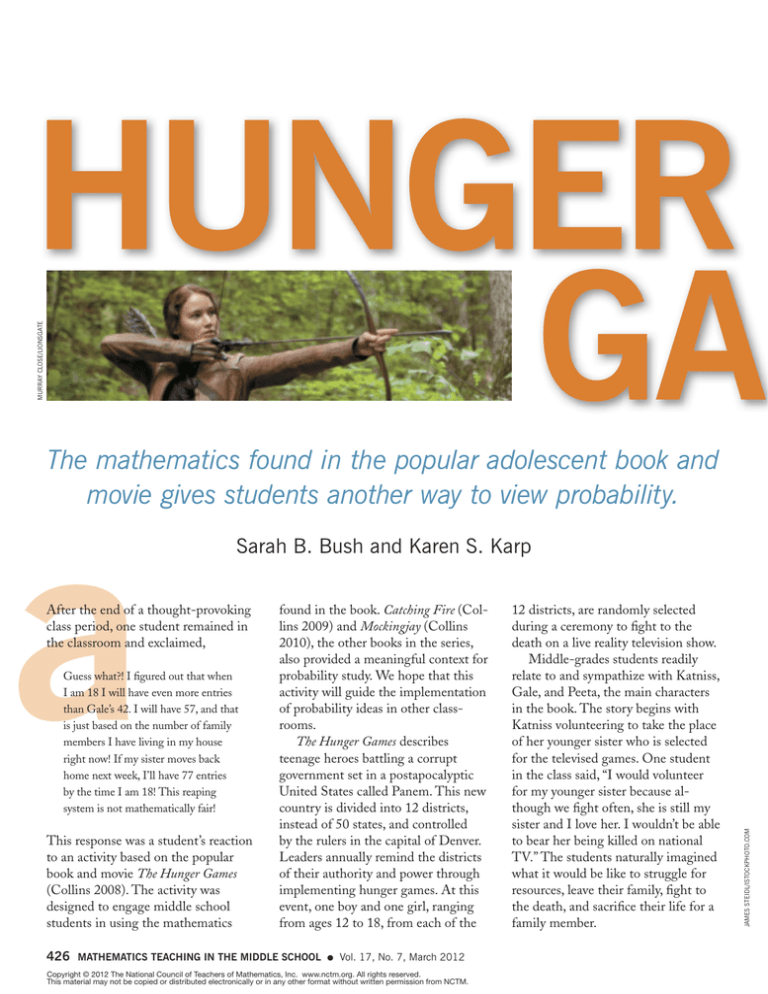
MURRAY CLOSE/LIONSGATE
hUngeR
gaM
The mathematics found in the popular adolescent book and
movie gives students another way to view probability.
After the end of a thought-provoking
class period, one student remained in
the classroom and exclaimed,
Guess what?! I figured out that when
I am 18 I will have even more entries
than Gale’s 42. I will have 57, and that
is just based on the number of family
members I have living in my house
right now! If my sister moves back
home next week, I’ll have 77 entries
by the time I am 18! This reaping
system is not mathematically fair!
This response was a student’s reaction
to an activity based on the popular
book and movie The Hunger Games
(Collins 2008). The activity was
designed to engage middle school
students in using the mathematics
426
found in the book. Catching Fire (Collins 2009) and Mockingjay (Collins
2010), the other books in the series,
also provided a meaningful context for
probability study. We hope that this
activity will guide the implementation
of probability ideas in other classrooms.
The Hunger Games describes
teenage heroes battling a corrupt
government set in a postapocalyptic
United States called Panem. This new
country is divided into 12 districts,
instead of 50 states, and controlled
by the rulers in the capital of Denver.
Leaders annually remind the districts
of their authority and power through
implementing hunger games. At this
event, one boy and one girl, ranging
from ages 12 to 18, from each of the
MaTheMaTicS Teaching in The Middle School
●
Vol. 17, No. 7, March 2012
Copyright © 2012 The National Council of Teachers of Mathematics, Inc. www.nctm.org. All rights reserved.
This material may not be copied or distributed electronically or in any other format without written permission from NCTM.
12 districts, are randomly selected
during a ceremony to fight to the
death on a live reality television show.
Middle-grades students readily
relate to and sympathize with Katniss,
Gale, and Peeta, the main characters
in the book. The story begins with
Katniss volunteering to take the place
of her younger sister who is selected
for the televised games. One student
in the class said, “I would volunteer
for my younger sister because although we fight often, she is still my
sister and I love her. I wouldn’t be able
to bear her being killed on national
TV.” The students naturally imagined
what it would be like to struggle for
resources, leave their family, fight to
the death, and sacrifice their life for a
family member.
JAMES STEIDL/ISTOCKPHOTO.COM
a
Sarah B. Bush and Karen S. Karp
?
MeS:
WhaT aRe The chanceS
Vol. 17, No. 7, March 2012
●
MaTheMaTicS Teaching in The Middle School
427
THE ACTIVITY
Part 1: Entries in the Reaping
The lesson was completed over two
fifty-minute class periods. Most
students in the classes had already
read The Hunger Games and were
able to explain the story line to the
few students who had not yet read it.
We took a few minutes and encouraged students to share their personal
insights about the story with the rest
of the class. Students were eager to
describe the main characters; discuss
the inhumanity of the story; and point
The Standards
at Work
The Common Core State Standards
for Mathematics (CCSSI 2010) and
NCTM’s Content Standards were
both used as guiding frameworks.
This activity addressed 4. Model
with Mathematics, a Common Core
Math Practice, which states that
mathematically proficient students
should “routinely interpret their
mathematical results in the context
of the situation” (p. 7).
This Hunger Games activity
also addressed 1. Make Sense of
Problems and Persevere in Solving
Them because students must “start
by explaining to themselves the
meaning of a problem and looking for entry points to its solution”
(CCSSM 2010, p. 6). This activity
also aligns well with the Common
Core Standards for seventh-grade
mathematics, which state, in part,
that students should “develop a
probability model and use it to
find probabilities of events” (CCSSI
2010, p. 51). Moreover, this activity can be related to the Curriculum
Focal Points (NCTM 2006) for
grades 6-8 in that students compute probabilities from simulations
incorporating organized lists and
tree diagrams.
428
out unfair elements of the reaping system, or student lottery drawing for the
televised games. Some students specifically explained how they connected
the story to their own life. Students
commented on what their life would
be like in the Panem district:
• “When I imagine having to live in
a Panem district, doing my homework doesn’t seem so bad.”
• “I couldn’t imagine having to kill
animals with bows and arrows just
so my family could eat.”
• “It would be awful to live in
District 12.”
Different discussions evolved from
each class period on the basis of students’ interests. This process engaged
the entire class and built a high level
of connection to the mathematical
activity.
After discussing the plot, students
were asked to imagine their class as
one of the 12 Panem districts. To
prepare for the lottery to select two
young people from each district for
the Hunger Games television show,
students first had to find how many
entries containing their name would
be placed in the annual reaping lottery. Students’ names were placed in
a drawing on the basis of their age
and neediness condition (resulting
in the need for tesserae, or additional
food resources). To find this neediness
amount, each student used a calculator with a random integer function.
Without telling students ahead of
time what their random calculatorgenerated results meant, each student
programmed their calculator to randomly select either a 0 or 1 using the
calculator’s random number feature.
Students were motivated by the
use of technology, but the same results
can be obtained by flipping a coin or
rolling a standard number cube. After
all students generated either a 0 or 1,
the teacher explained:
Mathematics Teaching in the Middle School
●
Vol. 17, No. 7, March 2012
Students’ paper entries
were placed in containers.
If your calculator generated a 0,
your family is not starving and you
do not have to submit extra entries
in exchange for food resources (or
tesserae) each year. If your calculator
generated a 1, your family is starving,
and you have always had to submit the maximum number of extra
entries each year since you were 12 to
feed your family (all members in your
household, including yourself ).
Students instantly realized what their
number 1 or 0 meant. The class burst
into cheers and groans at the same
time; the students knew that their fate
had been determined for their very
own hunger games.
Next, the class reviewed the
process and calculated the number of
times their names would be placed
in the drawing for the annual reaping. See figure 1 for guidelines on
how students calculated their number
of entries, which matches the story.
Student work examples are illustrated
in figure 2.
As student work was checked to see
whether they were correctly calculating
their own number of entries, a common misconception emerged. Several
students wanted to add the total number of entries for their age and add the
number of multiplicative entries for
tesserae in the same way. For example,
a 14-year-old student incorrectly
stated that six entries would result for
his or her age because
Fig. 1 This formula allowed students to calculate the number of entries into the annual
reaping for the hunger games.
One
student
kept
track as
the class
added
the total
number
of girldrawing
entries.
PART 1: AGE
Your baseline entries for each year are determined by your age.
1 (age 12) + 2 (age 13)
+ 3 (age 14) = 6.
However, age is not calculated multiplicatively, and this student should
have only 3 entries for age—1 for
each year. This issue was resolved
when student volunteers created the
chart found in figure 1, which highlighted how students should calculate
the entries based on age.
After all students had calculated
their final number of entries based on
age and received tesserae, they repeatedly wrote their names on pieces of
paper and placed the determined
number of entries with their name
into either the boy reaping or the girl
reaping lotteries.
Part 2: What Are the Chances?
After all entries were placed into the
lotteries by gender, students were
asked to identify what information
they needed to calculate their probability of being selected for the hunger
games. Students quickly decided that
the class needed to know the total
number of entries in each collection,
which we tabulated together as a class.
After the total number of entries for
boys and girls were found, the teacher
posed a series of questions in an activity sheet to engage students in thinking about the fairness (or unfairness),
probabilities, and possible outcomes
Age
Number of
Entries
12
1
13
2
14
3
15
4
16
5
17
6
18
7
PART 2: TESSERAE
In addition to the baseline number of entries (for your age), you must add
1 extra entry for every family member (including yourself) that received
tesserae. These extra entries are cumulative.
For example, if you are 14 years old, your baseline number of entries
would be 3 (1 for each year—12, 13, and 14). Added to this number
would be your tesserae. For example, if you have 5 members in your
family, the entries for tesserae at age 14 would be 5 × 3 = 15.
Number of entries = 3 (current age baseline)
+ 5 (extra for tesserae age 12)
+ 5 (extra for tesserae age 13)
+ 5 (extra for tesserae age 14) = 18.
IMPLICATIONS OF TESSERAE
A 14-year-old student with 5 family members receiving tesserae (if he
or she received a calculator-generated 1) would have 18 entries.
A 14-year-old student with 5 family members not receiving tesserae (if
he or she received a calculator-generated 0) would have 3 entries.
of the hunger games. See the activity
sheet at the end of this article:
• Items 1-2 align with Part 1:
Entries in the Reaping.
• Items 3-4 align with the individual
student’s chances of being selected
for the hunger games.
• Items 5-12 are follow-up questions that relate the mathematics
to the story and help students
imagine themselves as characters in
the story.
Vol. 17, No. 7, March 2012
●
Students immediately took an
interest in the activity sheet and were
placed in groups of three. Any student
who had not read The Hunger Games
was grouped with at least one other
student who had. They were eager to
compare their own chances of being
drawn in the reaping with those of
their classmates. Rachel stated, “Not
only is the number of entries you have
not fair, it’s also not fair that 18-yearolds have to go against 12-year-olds.”
We overheard a conversation between
Mathematics Teaching in the Middle School
429
Fig. 2 Students calculated their number of entries on the basis of age and tesserae needs.
a boy and girl who both had three
entries in the reaping. Although
they had the same number of entries
numerically, their entries were not the
same proportionally.
The boy’s chances of getting
drawn were much higher than the
girl’s chances because of the difference in the total number of boy and
girl entries in that class. Students also
discussed the probability differences
between different class periods on
the basis of class sizes, boy-girl ratios,
and the number of entries from each
student. Students told us:
430
• “My probability of being chosen
in another class period [district]
would be different from my
class period. This is because the
population of the class periods is
different, so the chance for me
changes.”
• “The chance for being selected
would be different in another
class period because of different
variables such as boy-girl ratio,
number of students, students
drawn for tesserae, and with different numbers of family members
to support.”
Mathematics Teaching in the Middle School
●
Vol. 17, No. 7, March 2012
FINDINGS FROM THE ACTIVITY
After groups completed the activity
sheet, the class reunited and discussed which questions were challenging and which results were interesting or surprising. Item 5, “Write
an algebraic equation representing a
person’s total number of entries for a
given year,” was difficult for students.
Generally, they were able to calculate
their total number of entries arithmetically but struggled to represent
the operations symbolically (adding
for age and multiplying for tesserae)
in the form of an equation.
Some students struggled to form
an equation until we helped them
define the possible variables. To help
them think about the variables that
determined their total number of
entries, we asked, “What factors cause
you to have entries?” “What operation
occurs with that variable?” “What if
your calculator generated a 0. Would
your equation still work?” See figure 3
for various student-created equations.
Students found a question involving permutations (item 9) and
another on grouping (item 12)
especially challenging. Most students
thought that the solution to item 9
was extremely large, so we took this
opportunity to discuss how switching the order of just 2 people (out of
the 24) counts as another possibility.
Some students incorrectly wanted
to find the number of combinations,
rather than permutations, of this
event.
To help students realize the difference between a combination and
a permutation, we wrote several
examples on the board of nearly, but
not exactly, identical orders for the
24 contestants. Making comparisons
seemed to help students conceptualize how there could be so many more
different possibilities in a permutation. For item 12, once students
visualized and illustrated what the
question was asking, many students
stated that it reminded them of the
well-known Handshake problem.
They then displayed creative ways to
find the solution. See the organized
list and diagram in figure 4.
Rounding percentages was another
common student misunderstanding. When calculating probability on
their calculators, students wanted to
round the decimal solution instead of
changing the decimal to a percentage
first and then rounding. For example,
if a student’s chances of being drawn
were 10 out of 248, he or she would
find 10 ÷ 248 = 0.0403225806 . . . on
the calculator. Next, he or she would
note that the directions asked students to round to the nearest hundredth percent. However, instead
of changing the decimal to a percentage first (4.03225806 . . . percent)
and then rounding their solution
(4.03 percent), students incorrectly
rounded their decimal to the nearest
Fig. 3 These student-invented equations answered question 5, which asked for an
expression representing the number of entries a person would submit in a year.
NEW from NCTM—A Common-Sense Approach to
the Common Core State Standards for Mathematics
Administrator's Guide: Interpreting the
Common Core State Standards to Improve
Mathematics Education
by Matthew R. Larson
This book includes answers
to frequently asked
ans
questions and detailed lists of resources to
support school mathematics programs.
Visit www.nctm.org/catalog for a table of
contents and sample pages.
Stock # 14288
List Price
$21.95
NCTM Member Price $17.56
For more information or to place an order,
please call (800) 235-7566 or visit www.nctm.org/catalog.
Vol. 17, No. 7, March 2012
●
bkadmin_509
NCTM journals 2/12
Mathematics Teaching in the Middle School
431
Fig. 4 Question 12 asked students to count the number of “confrontations” in systematic
ways.
CONCLUDING REMARKS
This activity provided a meaningful
way to connect probability to a work
of adolescent literature that related
to, was interesting to, and motivated
middle-grades students. The students
who completed this two-day activity
were engaged, eager to find solutions, and personally invested in the
story line and main characters. They
contributed valuable input and took
ownership of the activity. They also
took pride in the fact that they
remembered more facts about the
story than the teacher.
But more important, this lesson
gave students the opportunity to investigate the notion of chance events
and develop, use, and evaluate probability models as emphasized in both
the Common Core State Standards
for Mathematics and the Curriculum
Focal Points. Students’ perspectives
on the fairness of the hunger games
were both interesting and surprising.
We were most surprised by how students viewed fairness in two different
ways—as the fairness of one entry
in the reaping as a random selection
or as the fairness for the contestants
competing in the games. We read and
heard a variety of student responses:
(a)
• “This game would not be fair
because everyone had different
skills and different strategies
for competing.”
• “Considering that it’s a random
(b)
432
Mathematics Teaching in the Middle School
hundredth (.04) and wrote 4 percent
as their answer. This problem provided an ideal opportunity to help
students by providing additional
examples and showing connections to
work done earlier in the school year.
We circulated around the room, identifying students who had this misunderstanding and conducting quick
assessments. From their responses, we
were quickly able to ensure that they
grasped the concept.
●
Vol. 17, No. 7, March 2012
selection, yes, it is fair as far as
choice, but it is unfair because
not all contestants are equally
matched.”
• “Yes, because it is random, but it’s
also sort of not fair because some
people have 18 entries while
others have 2.”
GENERAL REMARKS
Students used reasoning and sense
making during this activity to address
mathematical situations from an
engaging context in meaningful ways.
Throughout the activity, students
expressed their disbelief at some of the
small calculated probabilities and some
of the large total possible outcomes, as
found on their activity sheet. These
discoveries provided a nice transition
to extended conversations about very
small and very large numbers and
the probability of winning a game of
chance, such as the lottery.
In some classes, we talked about
some games being based solely on
chance, such as the lottery; some
based on multiple variables, such as
the skill needed in horse racing; or
on both, such as found in card games.
It was not surprising that the issue
of fairness dominated students’
initial discussions about the story.
As their understanding of the underlying probability concepts became
more sophisticated, their ability to
separate various nuances in fairness
increased.
Students quickly applied their
new understanding to consequences
of finding a different total number
of entries for each class period. This
understanding and application grew
naturally as students grappled with
these concepts in the context of the
story and discussed the implications
of the antagonists with respect to
their personal situation.
Their ability to blend their personal and story contexts and share the
meaning of each in terms of fairness
as defined by probability contributed
to a very powerful learning experience. Students were happy that the
hunger games were only fiction, as
reflected in such comments as “I
would compete in the hunger games
if for no other reason than to escape
my fate in a district” and “It is tragic
that 23 people are going to die during
each annual hunger games.”
The use of this piece of adolescent
literature in the mathematics classroom helped students become more
mathematically proficient in many
ways. They developed a conceptual
understanding of probability concepts, learned flexibility while using
various procedures, solved mathematics problems strategically, engaged in
logical thought and reflection, and
believed that they could do math.
NCTM’s
Member Referral Program
Let’s Add Up! Refer. Receive.
Participating in NCTM’s Member Referral Program is fun,
easy, and rewarding. All you have to do is refer colleagues,
prospective teachers, friends, and others for membership.
Then as our numbers go up, watch your rewards add up.
Learn more about the program, the gifts, and easy
ways to encourage your colleagues to join NCTM at
www.nctm.org/referral. Help others learn of the
many benefits of an NCTM membership—
Get started today!
Vol. 17, No. 7, March 2012
●
mbrref0112_501
journals433
Mathematics Teaching
in the Middle School
Note: The Hunger Games, an adolescent novel, includes elements of
violence, so it may not be suitable for
all middle-grades students.
REFERENCES
Collins, Suzanne. 2008. The Hunger
Games. New York: Scholastic Press.
———. 2009. Catching Fire. New York:
Scholastic Press.
———. 2010. Mockingjay. New York:
Scholastic Press.
Common Core State Standards Initiative
(CCSSI). 2010. Common Core State
Standards for Mathematics. Common Core State Standards (College- and
Career-Readiness Standards and K–12
Standards in English Language Arts and
Math). Washington, D.C.: National
Governors Association Center for Best
Practices and the Council of Chief
State School Officers. http://www
.corestandards.org.
National Council of Teachers of Mathematics (NCTM). 2006. Curriculum
Focal Points for Prekindergarten through
Grade 8 Mathematics: A Quest for
Coherence. Reston, VA: NCTM.
Sarah B. Bush,
sbush@bellarmine.edu,
is an assistant professor
of mathematics education
at Bellarmine University in
Louisville, Kentucky. She
is a former middle-grades
mathematics teacher
who is interested in
relevant and engaging
middle-grades mathematics activities.
Karen S. Karp, karen@louisville.edu, is a
professor of mathematics education at the
University of Louisville in Kentucky. She is
a former member of the Board of Directors of the National Council of Teachers of
Mathematics (NCTM) and a former president of the Association of Mathematics
Teacher Educators (AMTE). She continues
to work in classrooms to support teachers of students with disabilities in their
mathematics instruction.
434
Mathematics Teaching in the Middle School
●
Vol. 17, No. 7, March 2012
activity sheet
Name ______________________________
HUNGER GAMES QUESTIONS
1. On the basis of your current age and whether your calculator randomly generated a 0 or 1, calculate how many entries
you would have in the reaping lottery this year. (If you received a 1, do not forget to add cumulative entries of tessarae
from past years.) Show all work.
2. Place your entries in the boy drawing or girl drawing (the total from question 1) using small pieces of paper from your
teacher.
Check when complete. _____
3. Given the grand total number of entries in your class (district) and for your gender, what is the probability that your
name would be selected? Express your answer as a percentage rounded to the nearest hundredth. Show all work.
4. Suppose you were a student in another class period. Would your chances (or probability) of being selected for the
Hunger Games be the same? Why, or why not?
5. Write an algebraic equation representing a person’s total number of entries for a given year. Define all possible
variables, and write your equation below.
6. If 11,500 total entries were in your district, and 42 of that number were your entries (similar to Gale in the book),
what is the probability that your name would be drawn for the Hunger Games? Assume that the 11,500 entries are
the same gender. Express your answer as a percentage rounded to the nearest hundredth. Show all work.
7. How many entries would you have if you were 18 years old, had 9 family members (including yourself), and received
tesserae for each of them (and yourself) every year since you were 12? Show all work.
8. Suppose you were Katniss and the name of your same-sex younger sibling was drawn for the Hunger Games. Would
you volunteer in his or her place? Why, or why not? Be serious.
9. During the Hunger Games in the book, 24 contestants fight to the death until only 1 is standing. This last person
standing is declared the winner. How many orders are possible in which the contestants could have been eliminated?
Assume that only 1 contestant is eliminated at a time. Show all work.
10.Similar to horse racing, citizens at the capital placed bets on who would win the Hunger Games. How many orders
are possible for the first, second, and third person eliminated? Assume that only 1 person can be eliminated at a time.
Show all work.
11.Suppose you were in a mathematics class of 24 students, and each student randomly draws the name of a contestant
from the Hunger Games. If your contestant wins the Hunger Games, you win a prize.
a. Is this a fair game? Why, or why not?
b. If it were a fair game, what is the probability of your contestant winning the Hunger Games? Assume that there is
only one winner. Express your answer as a percentage rounded to the nearest hundredth. Show all work.
12. Suppose that each contestant at the Hunger Games confronts all the other contestants but none die in the process.
How many total confrontations would there be for each contestant to confront all the other contestants exactly one
time? Use drawings or lists to help organize your thoughts. Show all work.
from the March 2012 issue of

